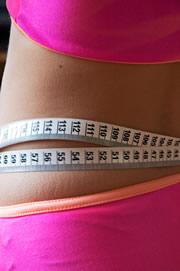 Is the figure in the mirror all in your mind?© Punchstock
Is the figure in the mirror all in your mind?© PunchstockScientists have harnessed a perceptual trick known as the 'Pinocchio illusion' to help pinpoint the brain regions that control how we view our bodies. They made the discovery by scanning the brains of volunteers experiencing the illusion, which involved stimulating their wrist tendons to make them feel thinner.
Previous studies have shown that vibrating the skin over specific tendons can warp a person's perception of their body size and shape. The vibrations can, for example, lead individuals touching their noses to believe that this part of their face is flattened or elongated, the effect that gives the Pinocchio illusion its name.
The trick also works to distort how people perceive their waist size. Stimulating the tendon on the wrist creates the sensation that the joint is flexing, even when it remains stationary. Thus, volunteers placing their hands on their waist are fooled into believing that their wrists are bending inwards around a slimmer body.
Henrik Ehrsson of the University College London knew about this illusion and wanted to pinpoint the brain region that it affects. He and his colleagues recruited volunteers to experience the mind trick while undergoing functional magnetic resonance imaging, a technique used to monitor brain activity.
Waisting away
All 17 of the subjects reported that they felt slimmer while experiencing the illusion. On average, they felt that their waist width was reduced by a quarter after their wrist tendons were stimulated. Recordings from muscles showed that their wrists had remained still during the test.
The volunteers' brain scans, meanwhile, showed a significant increase in activity in a region called the posterior parietal cortex, which helps to integrate sensory information from different parts of the body.
Those who felt the greatest slimming sensation also exhibited the biggest activity increase in this brain region. The results suggest that the posterior parietal cortex plays a crucial role in determining one's body image, say Ehrsson and his colleagues, who publish their results in the journal PLoS Biology1.
ADVERTISEMENT
They add that tendon stimulations that do not involve the assessment of one's figure will not cause this increase in brain activity. When individuals having one wrist stimulated put their own hands together, for example, their posterior parietal cortices showed no boost in activity, suggesting that this brain region deals only with body image, rather than simply body movement.
Ehrsson and his colleagues say that studying the influence of the posterior parietal cortex could help to improve the understanding and treatment of anorexia and other body-image disorders.
-
References
- Ehrsson H.H., et al. PLoS Biology, 3. e412 doi:10.1371/journal.pbio.0030412 (2005). | Article |
